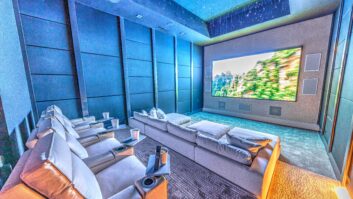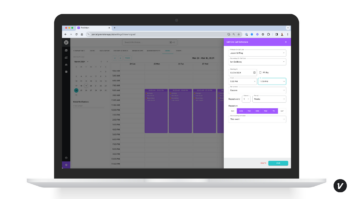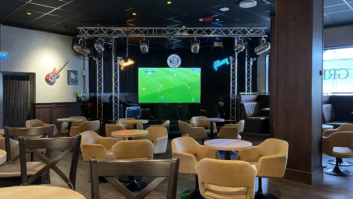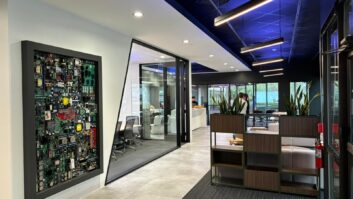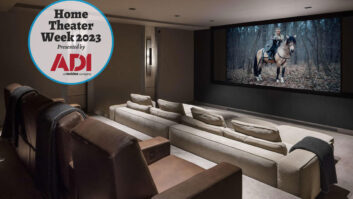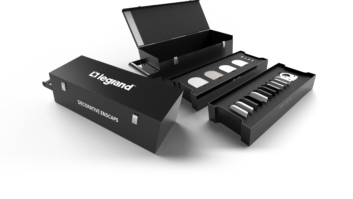
Crestron’s TSW touchscreens feature the same design elements that most consumers have come to expect from their mobile devices, such as capacitive touch and edge-to-edge glass. The impact that tablets, smartphones, and apps have had on the dedicated touchpanel market was seismic. But what started out as absolute disaster in terms of lost sales for control systems manufacturers was a motivating force behind new designs that could perform as good or better than any mobile device, with unique features and qualities that only dedicated panels can provide.
Core Brands control category director Joe Lautner said that there are a few distinct advantages that dedicated home control touchpanels have over tablets and smartphones.
“Dedicated touchpanels are always on, don’t rely on batteries, can’t get lost or misplaced, and because ours only run the ELAN g! software, there’s no app to open and no competing programs using processor power,” he noted. “Dedicated touchpanels ensure reliable, lightning-fast response to all input commands.”
Where smartphones and tablets fall short, Lautner added, is in their lack of hard buttons for common functions like lighting control and volume up/down/mute, plus the ability to act as an always-on intercom.

Each ELAN TS in-wall touchscreen has six hard buttons for one-touch access to commonly used functions and features a microphone and speaker for intercom use, a stylus for writing notes for family members on the screen, plus a video input that enables it to serve as a TV for kitchens and bathrooms.
“What really makes our touchpanels such an easy sell for clients already using Android or iOS devices is that the ELAN g! interface is the same on every device,” he pointed out. “So they can use their iPad or Samsung phone to check in on the home while they’re away, and then when they get home, there is a bright, large touchscreen that’s guaranteed to be [in the room], turned on, in the same spot every day, ready to go at a moment’s notice with no app to open and no loading time, and all the gestures and icons are identical to what they see on their mobile devices.”
Each ELAN TS in-wall touchscreen has six hard buttons for one-touch access to commonly used functions and features a microphone and speaker for intercom use, a stylus for writing notes for family members on the screen, plus a video input that enables it to serve as a TV for kitchens and bathrooms.
For customers accustomed to using Apple and Android devices, many of RTI’s touchpanel controls, including its new KX7 and CX7, offer a very familiar experience, with edge-to-edge color touchscreens providing the convenience of screen swiping through menus and pages. However, they also offer features that can’t be found on a mobile device, noted VP of sales and marketing Pete Baker, such as the ability to watch analog video from a home’s satellite TV set-top device directly on the controllers, proximity sensors that automatically bring the units to life when approached, and ambient light sensors that adjust screen brightness.

Leviton’s OmniTouch 7 screens feature a high-speed processor that allows swiping capabilities and high-resolution camera images commonly found on modern portable devices.
RTI’s KX7 (shipping since January 2013) and CX7 (shipping this month) are wired interfaces sporting 7-inch 800×480 WVGA LCD touchscreens and video quality up to 576p via composite, S-video, or component video inputs. The CX7 also is equipped with stereo speakers to provide sound directly from the controller and an adjustable tilt display, for mounting on a tabletop or under a cabinet.
Both controllers feature a high-output IR port to enable direct control of multiple devices without the need for a separate control processor. In addition, 10/100 Base-T (with PoE) and wireless 802.11 Ethernet provide two-way control and feedback from AV components and HVAC systems, as well as access to web pages and video from network security cameras.
Crestron’s TSW touchscreens feature the same design elements that most consumers have come to expect from their mobile devices, such as capacitive touchscreens and edge-to-edge glass. They also support gesture-driven graphics such as sliders, knobs, and scrolling lists just like mobile devices and tablets do. But, again, for added convenience, these dedicated controllers also include five soft-touch buttons for quick access to commonly used functions.
“Homeowners are now realizing that a control app on a tablet or phone is very convenient, but it isn’t the total solution,” said Delia Hansen, Crestron’s residential marketing manager. “When the iPad ‘walks away,’ a dedicated touchscreen is a must to provide consistent, reliable control. It offers instant access to quick controls like lighting and mute without interrupting that game of Angry Birds or your thought stream responding to that important email.”

RTI’s CX7 is a wired interface sporting a 7-inch 800×480 WVGA LCD touchscreen and video quality up to 576p via composite, S-video, or component video input.
Crestron’s TSW-1050, which began shipping in Spring 2013, offers H.264 video streaming capability that enables users to view content from media servers, including the Crestron Network Video Streamer, security cameras, web cameras, and other H.264 streaming video sources.
Utilizing PoE connectivity, all control, video, intercom, and power signals are transmitted over a single Ethernet wire with one connection. By obtaining operating power through the LAN wiring, PoE technology eliminates the need for a local power supply or any dedicated power wiring. Additionally, the TSW-1050 and TSW-750 wall-mount models install using a standard two-gang backbox and the TSW magnetically adheres to its mounting bracket, eliminating any visible screws.
Leviton Security & Automation’s director of product management, Thomas Morgan, pounded a similar beat, saying that, “While portability is a wonderful feature, a wall-mounted screen is always in the same place ensuring ease of use every time you need it.”
Leviton’s new wall-mounted touchpanels are designed to work in concert with a client’s portable devices.
“The latest OmniTouch 7 screens feature a high-speed processor that allows swiping capabilities and high-resolution camera images commonly found on modern portable devices,” Morgan said. “The completely redesigned interface is highly graphical, and the screen resolution is stunning.”

TiO, which recently entered the channel and will begin shipping its TouchStream 7 in-wall amplified streaming audio player with 7-inch high resolution touchscreen in Q1 2014.
Leviton is close to releasing apps for iOS and Android, essentially adding portable versions of the OmniTouch 7 interface. One key difference between the apps and the dedicated device is the ability to rotate the interface to a portrait orientation.
The OmniTouch 7, which began shipping in September, has a very small profile on the wall and a very thin bezel. An ambient light sensor recognizes changes throughout the day to ensure enhanced viewing angles regardless of time. And, because security is at the crux of Leviton automation systems, an LED indicator on the top right corner home screen is green when security is disarmed and red when armed. The POE-compliant OmniTouch 7 can be easily retrofitted with a single Cat-5, and it is compatible with all current Leviton controllers including the OmniLTe, Omni II, OmniPro II, Lumina, and Lumina Pro.
The form factor of URC’s TKP-7000 touchpanel is virtually identical to an iPad in that it has a very slim, sleek, low profile, 7-inch frame, pointed out marketing director Cat Toomey. It employs intuitive navigation for whole-house automation of AV, lighting, temperature, security and surveillance, door locks, shades, and most any electronic device. Exactly like they do on smartphones and tablets, users can move between screens by simple finger swipes.
Available since May 2013, the TKP-7000 can be personalized to display weather and climate information, time, music album cover art and metadata, and photo slide shows. It reflects full graphical feedback from URC and compatible third-party devices. With URC and supported cameras, customers also can view live, full-motion video from in and around the home.
Honeywell Security’s Total Connect Remote Services app replicates the Honeywell touchpanel or wall-mounted controller, with the same icons and functionality on both iOS and Android platforms, but on its dedicated devices, the company also offers Wi-Fi and Z-wave capabilities to make it easier for dealers to install the product without needing to pull Cat-5 cabling throughout a home, said Robert Puric, director of connected home product management.

The form factor of URC’s TKP-7000 touchpanel is virtually identical to an iPad in that it has a very slim, sleek, low profile, 7-inch frame.
With Tuxedo Touch with Wi- Fi, Honeywell dealers can add IP cameras to an end user’s system, helping close more sales and secure recurring monthly revenue opportunities, Puric added. “With Z-Wave technology, dealers can automate the end user’s home by adding lights, locks, shades, and thermostats to the system without needing to run wires,” he said.
Control4’s 7-inch in-wall touchscreen with camera has been on the market since early 2012, offering an identical interface to what’s available on the company’s iOS and Android apps. According to Paul Williams, VP of security and communications products, the company’s touchscreens integrate audio/video intercom capabilities, a beam-forming microphone, and wide band audio to enhance intercom sound quality, and PoE or high-voltage wiring with WiFi.
Vantage’s Equinox 73 touchpanel, which became available in September, offers a “swipe and tap” feature to enable the client to edit his or her own scenes. Equinox 73 and 40 are designed for easy installation and retrofitting utilizing Vantage’s two-wire or Ethernet bus. Both devices “wake” when they sense user proximity to the system and “profiles” provide full user interface flexibility to match any user, location, function, or time of day. The widget-based user interface provides three levels of navigation: 90/10 dashboard, full screen, and edit mode.
TiO, which recently entered the channel and will begin shipping its TouchScreen 7 in-wall amplified streaming audio player with 7-inch high resolution touchscreen in Q1 2014, was designed from the start for customers that embrace mobile devices. With that in mind, designers kept the interface layout relatively “flat” to mimic the experience that users are accustomed to with their mobile apps, explained Mike Anderson, president and CEO of the company. “Our TouchStream 7 (AZTS7) sports the horizontal orientation and 7-inch display found on standard tablets, and our TouchStream 4 (AZTS4) consists of a 4.7-inch portrait-oriented screen–a size and format that will make mobile users feel right at home.”

Vantage’s Equinox 73 touchpanel, which became available in September, offers a “swipe and tap” feature to enable the client to edit his or her own scenes.
The TiO TouchStream 4 and TouchStream 7 are essentially amplified audio zone players offering a portal to online streaming services, access to any DLNA-compatible media server on the home network, an integrated Bluetooth receiver, a 100W Class D digital amplifier and the option of wired or wireless internet connectivity. Perhaps most impressive, Anderson said, is that TiO TouchStream models can install into a standard, single-gang space, making them “a perfect retrofit solution for upgrading existing volume controls.”
As a complement to this functionality, the TouchStreams feature a patent-pending reflective inverse bevel that mirrors the wall color and provides a floating effect for a sophisticated touch.
So while control systems manufacturers might have been caught off guard when the tablet and smartphone app market took off, today’s dedicated touchpanel offerings have caught up and are now more stylish than ever, with features that consumer-grade products don’t offer.
“It’s important for our dealers to share these benefits with their clients,” said Core Brands’ Lautner.
Jeremy Glowacki is editorial director of Residential Systems and Systems Contractor News.
